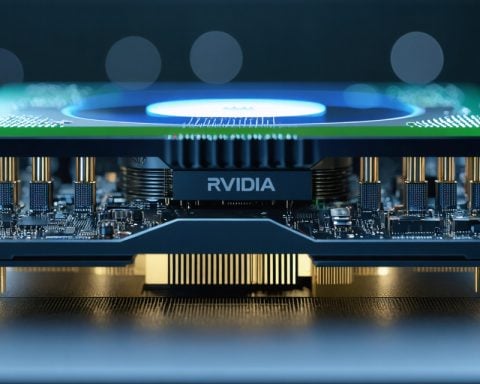- Topological qubits offer a groundbreaking advancement in quantum technology by reducing the need for extensive error correction found in traditional qubits.
- These qubits allow for a more efficient and scalable quantum computing system using precise digital controls instead of complex analog ones.
- Microsoft’s innovative design employs Majorana particles forming an “H” structure with aluminum nanowires, operating in extremely cold environments.
- The integration of these qubits with classical computing and AI could revolutionize computational power and capabilities.
- While promising, fully harnessing topological qubits may take years, yet their potential to transform various industries sustains strong interest.
Imagine a world where computers harness the quirky laws of quantum physics, propelling computation to dizzying new heights. That world may soon become reality, thanks to topological qubits—a groundbreaking stride in quantum technology. While traditional qubits quiver at the slightest environmental disturbance, demanding exhaustive error correction, their topological counterparts have rewritten the rules.
Microsoft has unveiled a remarkable new type of qubit that defies conventional quantum norms. These topological qubits dramatically reduce the need for error correction, requiring just a fraction of the oversight their traditional cousins demand. This shift allows for a sleeker, more efficient system, enabling quantum computers to scale without losing coherence. Instead of relying on cumbersome analog controls, these qubits harness the precision of digital control, paving the way for a more robust and scalable quantum architecture.
At the heart of this innovation lies a fascinating structure. Picture four Majoranas delicately engineered to form an “H” with aluminum nanowires. These structures tile together on a chip, their orderliness hiding the complexity within. These chips are cocooned in an environment chillier than the vacuum of space, while sophisticated software bridges them with classical computing and AI.
Despite this quantum marvel, the journey to taming this technology is far from over. Microsoft acknowledges that orchestrating the symphony of quantum components at scale could take years, but the promise of a faster, more powerful computational future keeps the pursuit fervent.
The allure of topological qubits lies not just in their innovative design, but in what they portend—a leap toward the future of quantum computing, one that may radically transform industries and scientific landscapes alike.
Unlocking the Quantum Frontier: How Topological Qubits Could Revolutionize Computing
How-To Steps & Life Hacks: Understanding Topological Qubits
Before diving into uses and comparisons, it’s crucial to grasp how topological qubits work:
1. Fundamentals of Quantum Bits: Traditional qubits can exist in multiple states simultaneously (superposition) but are highly susceptible to decoherence, requiring significant error correction. In contrast, topological qubits use braiding of particles in a quantum field to encode information, offering innate protection against noise.
2. Fabrication Process: Achieving topological qubits involves complex materials science. Majoranas are created at the intersections of superconducting nanowires, precisely controlled in sub-zero environments.
3. Digital Control Implementation: Unlike analog systems, which require constant fine-tuning, digital control allows qubits to be manipulated more precisely, minimizing errors and enhancing stability.
Real-World Use Cases
Topological qubits have the potential to redefine several industries:
– Cryptography: Their ability to solve complex algorithms with ease promises advancements in secure communications and data encryption.
– Drug Discovery: Quantum simulations can model molecular interactions at unprecedented speeds, accelerating the development of new pharmaceuticals.
– Material Science: By simulating materials at the quantum level, researchers can discover new compounds with unique properties, potentially leading to breakthroughs in technology and manufacturing.
Market Forecasts & Industry Trends
– The quantum computing market is expected to grow exponentially, with estimates predicting it could reach over $6 billion by 2025. Companies like IBM, Google, and Microsoft continue to invest heavily in this technology.
– The focus is shifting towards developing hybrid systems that integrate both classical and quantum computing, maximizing the strengths of each.
Reviews & Comparisons
– Topological Qubits vs. Superconducting Qubits: While superconducting qubits are currently more developed and deployed, they require extensive error correction. Topological qubits, though in earlier stages, offer a more stable and efficient means of scaling up quantum processors.
Controversies & Limitations
Despite their promise, topological qubits face challenges:
– Scalability Issues: Current technology can produce qubits at a lab scale, but mass production presents significant challenges.
– Resource Intensiveness: The extreme conditions needed to stabilize these qubits (near absolute zero temperatures) demand significant energy and infrastructure.
Features, Specs & Pricing
– Features: High fault tolerance, digital precision control, and low overhead for error correction.
– Pricing: Due to the nascent state of the technology, costs remain high but are expected to decrease as methods become more efficient.
Security & Sustainability
– Security: Their robustness makes them less prone to quantum attacks, crucial for protecting sensitive data.
– Sustainability: While currently energy-intensive, advances in refrigeration and chip design could mitigate the environmental impact.
Insights & Predictions
Topological qubits will likely revolutionize various fields, though development may take several more years. As the technology matures, industries should prepare for integration through training and infrastructure updates.
Tutorials & Compatibility
– Compatibility: Integration with classical computing systems through sophisticated software is essential for processing data efficiently.
Pros & Cons Overview
– Pros: Reduced error rates, scalability, and enhanced computational power.
– Cons: High initial costs, complex infrastructure requirements, developmental uncertainty.
Actionable Recommendations
– Stay Informed: Regularly follow updates from leading tech companies to understand the evolving landscape of quantum computing.
– Invest in Skills: Training in quantum programming and familiarizing with quantum mechanics can offer a strategic advantage.
– Evaluate Investments: Consider investing in startups and established companies making headway in quantum technology.
Suggested Related Links
For more insights on this topic, visit Microsoft and IBM.













